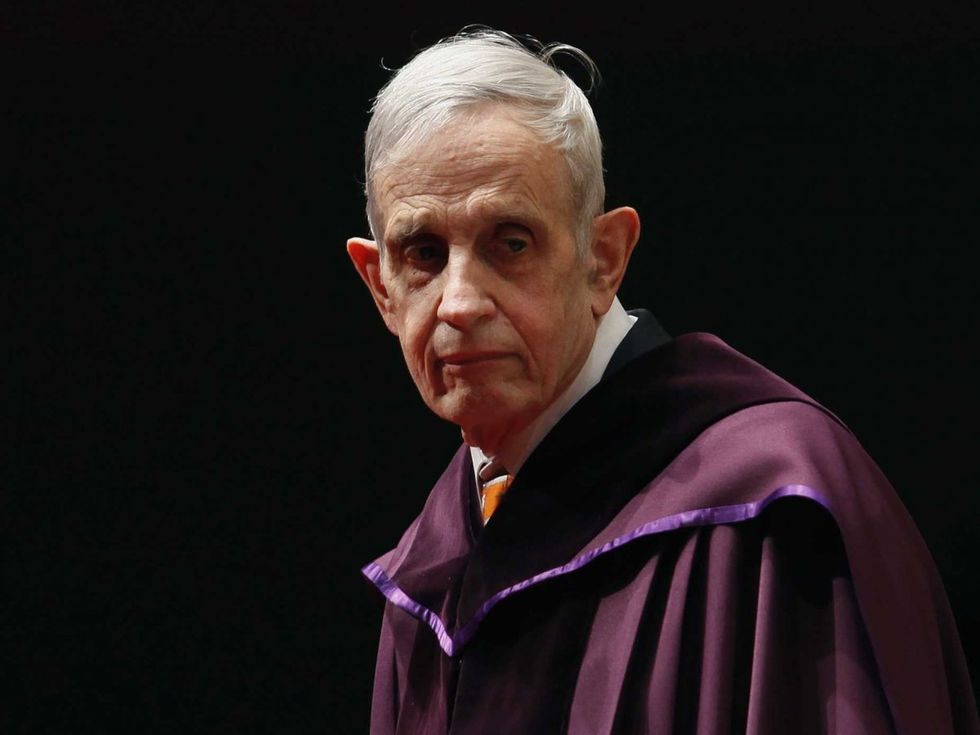“The only thing greater than the power of the mind is the courage of the heart.”
Few mathematicians throughout history have managed to capture the interests of both lovers of logic and the brain as strongly as John Nash. Revolutionizing the game theory (the field of mathematics focused on interdependent choices made by parties) and contributing to the study of partial differential equation, Nash was one of the most notable mathematicians of the 20th century. However, Nash's notability is seen not only in his mathematical brilliance, but also in the divergence of his mind; Nash was a diagnosed schizophrenic, meaning that he suffered from paranoid delusions and hallucinations. As we explore the life and work of John Nash, we will begin to see how this mental illness helped to define Nash's influence on modern mathematics.
It is often said that the buildup of abuse, trauma, and suffering is what prompts the birth of the genius. This, however, is not true in the case of John Nash. Born on June 13, 1928 in Bluefield, West Virginia to John Nash Sr. and Margaret Virginia Nash, John Nash's childhood was less than notable; he suffered from no psychological or physical damage, and lived a relatively pleasant life. Nash was inspired by his immediate family to pursue education, and was given many opportunities to do this throughout his childhood; his studies of advanced mathematics began during his final year of high school, and began his studies of chemistry at the Carnegie Institute of Technology, where he would eventually change his major to mathematics, and received both a Bachelor's and a Master's degree in said field. Two years after he would receive a Doctorate in mathematics from Princeton. During his time at Princeton, Nash would formulate the now-famous Nash Equilibrium, a solution to the dynamics of competitors. Though Nash had planned to further pursue research, his battle with schizophrenia would soon begin.
Paranoid schizophrenia is a subset of schizophrenia that induces severe psychosis and causes one to draw away from society, believing that those around them wish to harm them. John Nash's struggle began with the belief that Aliens were attempting to contact him through the New York Times newspaper. He then left the United States, looking to renounce his citizenship status and to become a refugee, causing his wife, Alicia Nash, to fall into a deep depression. Alicia Nash had her husband admitted to mental institutions twice in hopes that her husband would recover, subjecting him to harsh and experimental forms of treatment for his mental illness. Nash was aware throughout his life that he possessed attributes that could have been seen as warning signs of the illness:
"Some decisions that might not have been the most rational. Times I didn't follow the norm, thought differently. But I can see there's a connection between not following normal thinking and doing creative thinking. I wouldn't have had good scientific ideas if I had thought more normally. One could be very successful in life and be very normal, but if you're Van Gogh or artists like that you may be a little off."
Nash's fame soon turned into infamy as this news reached the general public. Nash would eventually, to the surprise of psychologists of the time, recover from schizophrenia and further pursue mathematics as he had done years before, eventually being rewarded with a prestigious Nobel Prize in 1994. Considering that Nash's son would eventually be diagnosed with schizophrenia as well, it can be inferred that Nash's schizophrenia was genetic.
Nash's intriguing life and work would eventually be immortalized in the film A Beautiful Mind, which serves as a fictitious biography of Nash starring Russell Crowe. Though the film illustrated Nash's work accurately, it took many liberties in terms of his life and, particularly, his mental illness; Nash seldom suffered from visual hallucinations despite what the film presented, and his discovery of the Nash Equilibrium was far less dramatic in reality. Despite this, Nash overall found the film acceptable:
"It's inaccurate, but it's sort of interpretative; the screenwriter is really responsible for that, and he had a mother who was a psychiatrist and this is very relevant because he was sort of into the area."
Though Nash's story of success in mathematics and in overcoming schizophrenia is one that inspires great wonder, every story must eventually come to an end. John Nash and his wife, Alicia Nash's stories ended in New Jersey in the year 2015 when the taxi they were riding in lost control and crashed into a guard rail, ejecting the couple, aged 86 and 82 respectively, from the vehicle, where both were pronounced dead on scene. Though Nash died, his legacy would live on through his work and his story, which had been gaining constant fame since published.
Though Nash's name is not as well-known as some other mathematical greats such as Einstein's or Pythagoras's, Nash's intriguing nature comes not only from his work in the field of mathematics, but also in his unique struggles and, in the end, in his imperfections. Though Nash was given many opportunites throughout his life due to his parents' wealth and status, he lost all credit when the public came to the realization that he was mentally ill, a label even more damaging during the mid-20th century than it is now. To achieve the titles he has earned now, Nash had to prove himself, once again, as an intellectual capable of great discovery.
Citations:
Grinberg, Emanuella. "'Beautiful Mind' mathematician John Nash dies in crash." CNN. Cable News Network, 24 May 2015. Web. 25 June 2017. <http://www.cnn.com/2015/05/24/us/feat- john-nash-wife-killed/index.html>.
"John F. Nash Jr. - Biographical." Nobelprize.org. N.p., n.d. Web. 25 June 2017.
PBS. Public Broadcasting Service, n.d. Web. 25 June 2017.
"Schizophrenia Daily News Blog." Schizophrenia Daily News Blog: John Nash Interview. N.p., n.d. Web. 25 June 2017.
The Editors of Encyclopædia Britannica. "John Nash." Encyclopædia Britannica. Encyclopædia Britannica, inc., 20 Apr. 2017. Web. 25 June 2017.



















